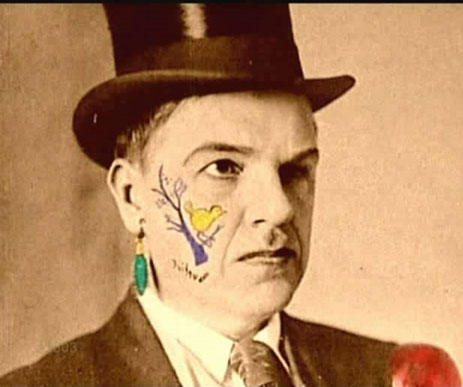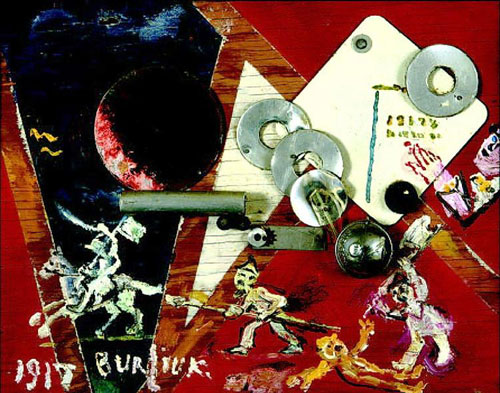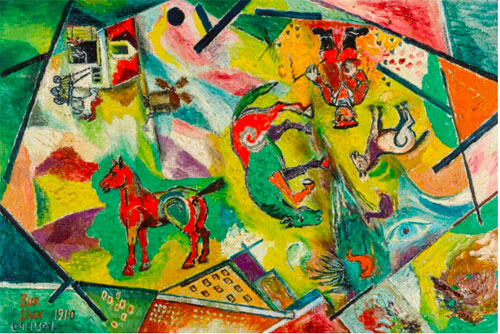|
This
last
February,
guest
writer
Gregory
Vernitsky
brought
into
this
series
the
figure
of
painter
David
Burliuk,
who
is
generally
recognized
as
the
Father
of
Russian
Futurism.
Gregory
gave
us
tantalizing
glimpses
of
how
Burliuk
crossed
paths
with
Kandinsky
[see here].

David Burliuk, with face paint and earring.
From this flowered some interesting private exchanges with both Gregory
and Jelena, the latter a frequent contributor to this series. I'm not selfish
enough to keep their letters to myself so, with their permission, I am
sharing them for readers here. (My contributions are in italics.)
*
As a preface, here is a delightful piece of miscellanea from Gregory.
Beyond his art student life in Odesa in the 1960s and '70s, I learned of his
very early involvement in an important children's theatre, and pressed
him for more:
I'm not sure if I can count these, but—I tie-dyed some simple tunics for
costumes, and modeled the head of a very ugly Father of the City to be
placed on a partition in the middle of a scene. In a play by Jerzy Jurandot,
I also played one of three angels sent to check whether Sodom could be
saved. Another angel—M. Rashkovetsky—is now a leading Ukrainian art
critic and museums organizer. The wife of the third angel is a director of
the Bleschunov Museum in Odesa. Quite an important time…

"Revolution," 1917
Presently,
Gregory
sent the following, describing Burliuk from the
perspective of many of his generation:
Regarding Burliuk—he wasn't romantic—he was a serious artist, a practical
and savvy guy. He sat out the Revolution and Civil War in Siberia, went to
Moscow, was almost killed and left Russia for good. He was 40—not
exactly a young man. On the other hand, he never lost his leftist spirit—his
friends were socialist artists, and in 1940 he even begged the Soviet
Government to accept his own large collection of Mayakovsky related
materials. But we, in the '60s and '70s, didn't know him as an important
artist, only as a scandalous author of shocking poems and catchy
revolutionary posters. Our leaders were old and ugly, the Revolution was a
bloody mess, full of betrayal, violence and senseless destruction—but for
most young people it was a romantic, idealistic struggle for a better future.
And Burliuk, as a rebel against established norms, was a part of it.
It was a long way to overcome Soviet propaganda.
It wasn't only an Iron Curtain; it was also the other side of a mirror.
*
Next,
Jelena
sent me some preliminary remarks on Burliuk. The "Slap in
the Face" she refers to was a manifesto-like statement Burliuk published
in a tone we might now associate with Punk—that is, incendiary, vulgar,
insulting, jarringly uppity. With phrases such as "perfumed lechery" and
"filthy slime," revered writers such as Pushkin, Dostoevsky and Tolstoy
were to be jettisoned to make room for the new. In short, Burliuk and
cohorts spit in the eye of the high-profile cultural figures that preceded
them. [The link to the full text is below.] This was published in the first
collection of Cubo-Futurist poetry, which listed Kandinsky's name
prominently among its supporters and included four of Kandinsky's
poems.
Kandinsky was understandably, well, pissed off. He hadn't given
permission to use his name or texts for such an endeavor, only found out
about it by chance, and asked a Moscow newspaper to print his stern note
of displeasure. Ever the lawyer and teacher, and sixteen years older than
Burliuk—and pretty kind considering how mad he was—Kandinsky
worded part of his objection this way [translation Lindsay/Vergo]:
… I warmly condone every honest attempt at artistic creativity, and I
am prepared to forgive even a certain rashness and immaturity of
young authors: with time and with the correct development of talent
both faults will disappear. But under no circumstances do I consider
permissible the tone in which the prospectus was written. I condemn
this tone categorically, no matter whose it is.
Some years later, though, Kandinsky sent long-distance greetings to
Burliuk through a mutual colleague. Now to Jelena:
Kandinsky exhibited the Burliuk brothers Vladimir and David in
Munich—great avant-garde; Vladimir [d. 1917] the better one! (Munich's
Lenbachhaus owns a few.) Kandinsky was also exhibited by David Burliuk
in Moscow, and said that David Burliuk was very sweet and helpful
(although he was a loud rascal!). They exchanged art works and letters. But
in 1913, Kandinsky distanced himself in response to Burliuk's radical, even
brutal, publication, "Slap in the Face of the Public."… My Slavic professor
knew David Burliuk very well in New York, and I own some of his late,
somewhat ridiculously self-centered souvenir-journals, with his
retrograde, figurative art in them. But he was able to afford living in
Florida every winter. He faked his good early avant-garde work, which he could not take along when leaving Russia the Eastern-China way; very difficult, and it took a long time...
*

"Farm Seen from the Air," 1910. Sold at Sotheby's in 2021 with the Note:
"Despite the date inscribed on the picture, this painting was executed
significantly later in the United States."
Not long after, Jelena filled out her remarks.
My Heidelberg professor of Slavic Studies, Dmitry Tschizhevsky, had
formerly taught at Harvard, and at that time he had been in close contact
with David Burliuk. In Heidelberg he continued (at least from 1959 on) to
receive Burliuk's journal, Color and Rhyme where, in my opinion, the
painter exaggerates his importance within the Russian-Ukrainian
avant-garde movement. Admittedly he and Mikhail Larionov had been the
leading figures in Moscow, and Burliuk definitely always the loudest one,
but as an artist less esteemed than his brother Vladimir. Kandinsky liked
him and the whole gang, exhibited him in Munich in 1911/12, printed
Burliuk's article about "Anarchy in Painting" in the famous almanac, The
Blue Rider, found him helpful when he and the Munich group were invited
to exhibit with the Knave [Jack] of Diamonds artists' group in Moscow.
They exchanged letters and paintings and had projects in common in
Russia—until… [here Jelena referred again to the "well-known" "Slap"
incident.]
So since the director of Lenbachhaus Munich, Hans Konrad Roethel, knew
that I was familiar to some extent with David Burliuk, he told me a secret,
an embarrassing one:
In 1960, (when I was not yet his assistant) he had planned an exhibition
with David Burliuk, finding his early, half-abstract works interesting:
"Everything was arranged, and the artist arrived in Munich with a large
wooden chest full of paintings. As usual, after being shipped, such chests
have to wait for a while before being opened; also I preferred to open it by
myself in the evening. That was a good decision, there were no witnesses.
Because the first thing that shocked me was the smell of fresh oil color.
And then I had a sleepless night. How to tell Burliuk that he was fooling
me, that he had "faked" his old motifs and insisted that he had saved them
all and brought them to America. How was I going to make clear to him
that I simply could not dare an exhibition now? The next morning we met,
but instead of accusing him I simply said that an exhibition would not be
possible. His reaction? No reaction! As if he had expected it, he simply left
together with his chest full of his 'new-old' paintings." — I asked a close
friend of Roethel's if she knew that story, but no. I suppose it was too
embarrassing to talk about at the time. But of course in the Burliuk
literature a 1960 exhibition in Munich is mentioned anyway!
And of course he was not the only one—the artist Pavel Mansurov and
many others did the same, and some museums had a hard time finally
admitting what they were showing on their walls. Making one's "own fakes"
is certainly a lesser crime than making "unauthorized fakes" by just
anyone. Is there a new category for such "post"-artworks?
About these "auto-fakes," perhaps something shifted for Burliuk over
time: Somewhat later, Jelena sent me her own copy of a Burliuk
catalogue by Elena Basner. On page 8, I spotted this passage:
"David never tried to conceal his repetitions of his own early works. When
publishing several of his later replicas, he would inform the public that
those particular earlier works of his had been lost, and so he had repeated
them in his own hand."
* * *
Link to brief specifics on the writing of "Slap" and the full text of it:
https://vk.com/wall-35831937_3724?lang=en
|